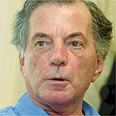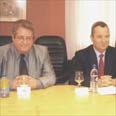

Diplomatic negotiations with Syria started in essence on July 29,1994, when the "Ambassadors' channel" was launched in Washington; A track of talks between Prof. Itamar Rabinovich, Israel's ambassador to the United States and Prime Minister Yitzhak Rabin's personal envoy, and Walid Muallem, at the time Syria's ambassador to the US and today the Syrian foreign minister.
This channel, with American intermediation, led that same year to a historic first and secretive meeting between Chief of Staff Ehud Barak and his Syrian counterpart Shihabi.
At the end of the meetings, the two were photographed at the White House with President Clinton. The Israeli delegation was certain it was a success story and informed Rabin he should prepare for the next step. This impression was false, however: Late Syrian President Hafez Assad was infuriated with the Israeli demand presented by Barak, according to which most of the Syria army would be shifted north of Damascus.
On Assad's directions, additional planned army chiefs' meetings were cancelled, but quiet diplomatic contacts continued. Slowly, the conditions were ripe for another chief of staffs meeting. Rabin directed Army Chief Lipkin-Shahak to head to Washington.
The charged meeting between Shahak and Shihabi was held on June 28, 1995. Shihabi presented a tough position. He spoke about limited security arrangements, including the demilitarization of relatively small areas on both sides on the border, where foreign troops could be stationed. Beyond those areas both countries would be able to deploy limited forces, "let's say, like your Division 36," Shihabi proposed. Monitoring means would include balloons, surveillance aircraft, and other technological means, but would not include physically infiltrating the other side's territory.
Brigadier General Zvi Shtauber, who spoke on behalf of Israel on the issue of security arrangements, presented four conditions that angered Shihabi: One of them was an unwillingness to obligate to full withdrawal from the Golan (he didn't know at the time that Rabin already made a pledge to American Secretary of State Warren Christopher to withdraw from the entire Golan Heights should all of Israel's needs be met.)
Other Israeli demands included insistence on Israeli presence on Mount Hermon, considerable expansion of demilitarized zones, and Israeli intervention in the Syrian army's structure.
At that point, Shahak raised a surprising proposal: In exchange for Israel's cutting edge intelligence post on Mount Hermon, Israel would grant the Syrians a parallel post on the peak of Mount Canaan, located inside Israel and near the IDF Northern Command headquarters in Safed.
This time too talks ended at President Clinton, and this time too they ended with the Israeli side sensing success. Yet just like in the first meeting, it turned out that the sense of satisfaction on the Israeli side was false. The Syrians were dissatisfied.
Assad changed course
One of the main points of controversy was the depth of the withdrawal near the Kinneret (Sea of Galilee.) Israeli representatives agreed to revert to the 1923 international border, to a distance of about 10 meters (roughly 30 feet) from the lake, but under no circumstances to the 1967 border, which was right at the shoreline. The difference between those two lines is very small in the Kinneret and a little larger in the Jordan River area, yet the Syrians wanted to sit on the beach and also added a demand for one third of the Kinneret itself.
The deadlock was surprisingly broken in October 1995: Hafez Assad changed course. Two weeks before the Rabin assassination, Martin Indyk and Dennis Ross rushed to Israel. We visited Assed, they said. He wants to renew the talks and close a deal.
Rabin agreed, but asked for three months for internal preparations. Tell him in my name that in January 1996 we shall renew negotiations and complete them with a full peace agreement. I'm willing accommodate him, Rabin said. His murder choked this initiative as well.
After Netanyahu was elected to lead the country, he sent his people to annul the pledge made by Rabin to Christopher. On the other hand, he attempted to secretly continue on the path initiated by Rabin and Peres, but was unsuccessful.
Barak's election for prime minister in July 1999 marked the renewal of negotiations. This time the Americans attempted to "sell" to the Syrians a deal that is seemingly bad for Israel: An almost full withdrawal, including the territory of all Syrian fishing villages near the Kinneret, but not to the shore line, which in any case withdrew several dozen meters West over the years.
Clinton, armed with this map, headed to a meeting with Assad on March 26, 2000, where he presented the new plan as an American idea he would agree to force on Israel. Assad refused. Following that meeting in Geneva, the direct Syrian channel in fact died away and has not been rehabilitated to this day.
In the absence of direct talks, contacts between the countries were based on indirect talks only, usually through private initiatives that failed to reach any results.
Sharon did not quite mourn over this. For example, he directed former Foreign Minister Silvan Shalom to freeze the contacts led by Foreign Ministry Director General Eytan Bentsur with Bashar Assad's brother and sister.
The Syrians relayed Assad's demand to continue the negotiations from the same point where it ended during the Rabin era, or in other words, demanded the fulfillment of Rabin's pledge to Christopher to "withdraw from the entire Golan Heights." Sharon strongly objected.















